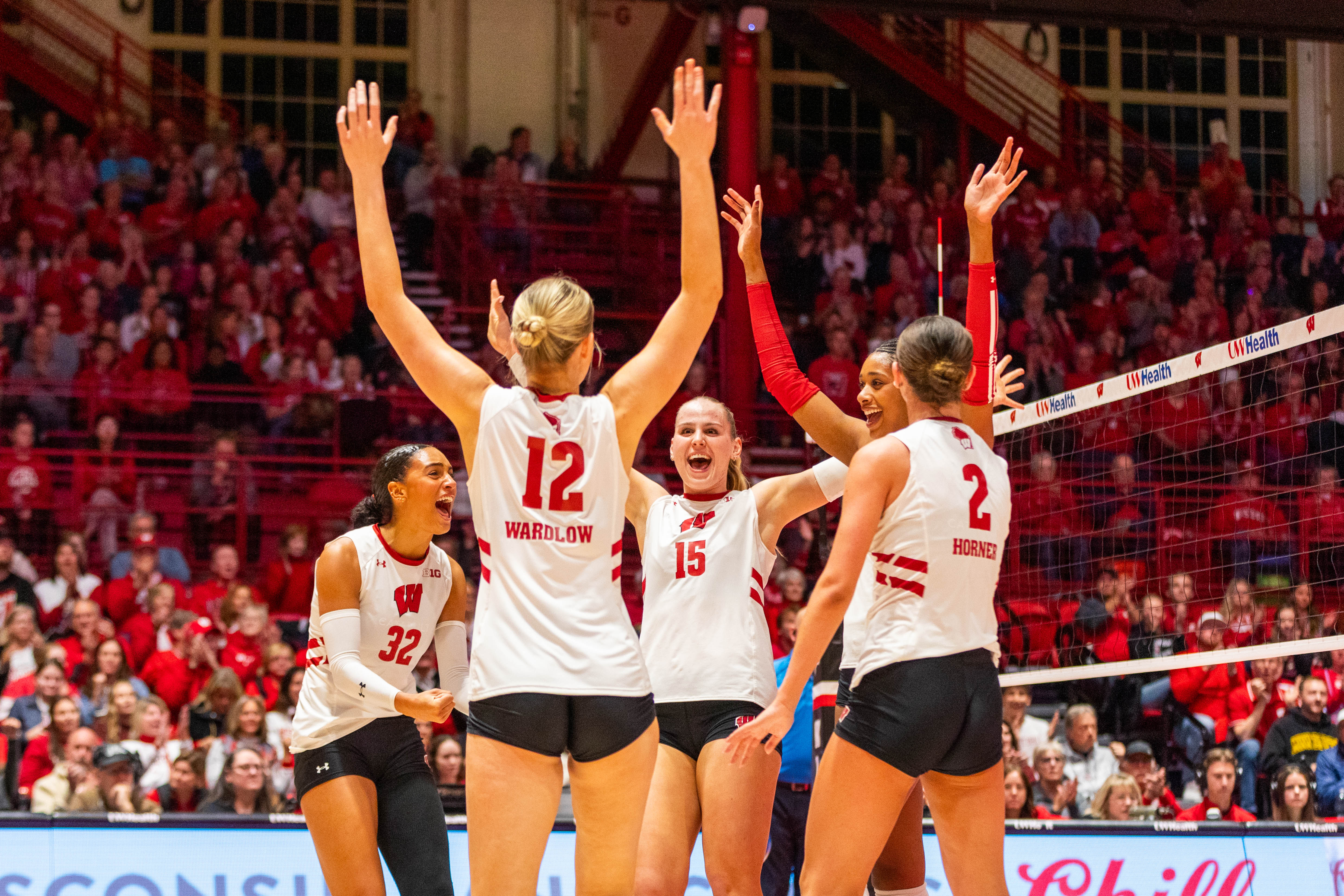Wisconsin Badgers Volleyball’s Gritty Win Over Minnesota Marks a Turning Point in a Season Defined by Struggles and Resilience, Echoing the Fight for Redemption in Today’s Divisive Climate of Competition and Survival
The Wisconsin Badgers volleyball team has shown a remarkable transformation in their performance, particularly highlighted by their recent victory over the Minnesota Golden Gophers. This match, held on November 5, 2025, at the UW Field House, was not just a win; it was a testament to the grit and determination that head coach Kelly Sheffield has sought to instill in his players throughout the season. Earlier in the year, Sheffield candidly acknowledged that his team lacked the necessary toughness, a quality that is often the difference between success and failure in high-stakes sports.
The Badgers, ranked No. 11, faced off against No. 22 Minnesota in a match that showcased two of the top outside hitters in the Big Ten Conference: Wisconsin’s Mimi Colyer and Minnesota’s Julia Hanson. Colyer, who has been a standout performer for the Badgers, entered the match with an impressive average of 5.2 kills per set, while Hanson was close behind with 4.1. Both players delivered exceptional performances, each recording 21 kills, but it was Colyer’s ability to maintain her composure and effectiveness under pressure that truly stood out. Sheffield praised her as “one of the top players in the country,” emphasizing her role in the team’s offensive strategy, particularly during moments of adversity.
The match’s dynamics were further complicated by Wisconsin’s serve-receive challenges, which were exacerbated by Minnesota’s aggressive serving strategy. The Gophers managed to ace the Badgers seven times, a significant increase compared to previous opponents. This aggressive approach put pressure on Wisconsin’s passing game, forcing them to adapt quickly. Libero Kristen Simon noted that Minnesota’s servers targeted the spaces between passers, creating a difficult environment for the Badgers to maintain their rhythm. Despite these challenges, Wisconsin’s resilience shone through, as they managed to overcome these serve-receive woes and secure the victory in four sets: 25-20, 25-22, 18-25, 25-16.
Addy Horner, the freshman setter, played a pivotal role in the match, despite facing a challenging period where her performance dipped. Sheffield’s decision to confront Horner during the game reflects the high expectations placed on young players in competitive environments. Horner rebounded from this moment, delivering critical sets that contributed to Wisconsin’s impressive .311 hitting percentage, their second-highest against a ranked opponent this season. Her ability to serve effectively in the fourth set, including three aces, helped solidify the Badgers’ lead and demonstrated her growth as a player.
The match against Minnesota was more than just a contest between two ranked teams; it was a microcosm of the broader themes of resilience and grit in competitive sports. The Badgers’ journey this season has been marked by struggles, but their recent performance indicates a turning point. The ability to learn from setbacks, adapt strategies, and maintain mental fortitude is essential for success, especially as the season progresses and the stakes rise in the postseason.
Wisconsin’s victory also highlights the importance of teamwork and collective effort in achieving success. While Colyer’s individual brilliance was on display, the contributions from middle blockers Carter Booth and Alicia Andrew, as well as outside hitter Una Vajagic, were crucial. This collaborative effort underscores the notion that while individual talent can shine, it is often the synergy of the team that leads to victory.
As the Badgers continue their season, the lessons learned from the match against Minnesota will undoubtedly serve as a foundation for future challenges. The ability to confront adversity, adapt to opponents’ strategies, and maintain a competitive edge will be critical as they aim for a strong finish and a favorable position in the postseason. The narrative of grit, resilience, and teamwork resonates not only within the realm of sports but also in the broader context of life, where challenges are met with determination and the pursuit of excellence.
MADISON — The Wisconsin Badgers “weren’t that gritty of a team” earlier in the 2025 season, as longtime volleyball coach Kelly Sheffield saw it.
“But we’re learning to be that right now,” Sheffield said. “And that’s what we’re going to have to be.”
That grittiness was on display as No. 11 Wisconsin defeated No. 22 Minnesota in four sets, 25-20, 25-22, 18-25, 25-16, on Nov. 5 at the UW Field House in a win that will surely help the Badgers’ postseason résumé.
Here are three takeaways from the four-set win:
Mimi Colyer delivers again in battle between elite outside hitters
The Wisconsin-Minnesota match featured two of the best outside hitters in the Big Ten. Wisconsin’s Mimi Colyer entered the match ranking second in the conference with 5.2 kills per set, and Minnesota’s Julia Hanson ranked fourth in the conference with 4.1.
Both players delivered impressive performances at the UW Field House.
"I thought people were treated to two elite outside hitters," Sheffield said at the beginning of the post-match press conference.
Hanson had 21 kills while hitting .333 and attempting more attacks than Minnesota’s two next-highest players combined.
Colyer, meanwhile, had 21 kills while hitting .326. It was the Oregon transfer’s sixth match this season with at least 20 kills and her eighth consecutive match with at least 12 kills.
“She’s one of the top players in the country,” Sheffield said of Colyer. “When you have somebody like that that can take a lot of swings when we’re scrambling, that’s what an elite outside hitter does. … The other thing that she’s doing a good job with tonight if we’re finding her a little bit more in the back row.”
Wisconsin’s attack was hardly just the Colyer show, however. Middle blockers Carter Booth and Alicia Andrew combined to record 11 kills on 19 total attacks without any attack errors. Outside hitter Una Vajagic had 11 kills while hitting .259.
“I thought we were putting our hitters in really good positions,” Sheffield said.

Addy Horner bounces back
Addy Horner “did a really nice job setting,” Sheffield said in his opening remarks of the post-match press conference.
But Sheffield also mentioned later that the freshman setter had a “poor 15 minutes of the match” against Minnesota — poor enough to draw Sheffield’s ire.
“I kind of jumped on her a little bit, which is not something I typically do too much in game at a setter,” Sheffield said. “But she’s a pretty tough cookie and got right back to work and was really delivering some great balls.”
Wisconsin hit .311 against the Gophers, which was its second-highest hitting percentage against a ranked opponent this season. (The one better performance was UW’s .488 hitting against then-No. 21 Georgia Tech although the Yellow Jackets have since fallen out of the rankings.)
Horner also stepped up from the service line in the fourth set. She had three aces, two of which were in a serving run where the Badgers expanded their lead to a commanding 23-15.
“She had one where the court kind of just really opened up, and the ball dropped uncontested,” Booth said. “It helps build that momentum to finish strong and close it out really well.”
Wisconsin overcomes serve-receive woes
Minnesota challenged Wisconsin’s serve-receive game in a way that no other opponent has done in 2025.
The Gophers aced UW seven times in the four-set match — two more times than any of UW’s previous 20 opponents did.
“They’re just really aggressive behind the service line, really attacking into space between the passers,” UW libero Kristen Simon said.
It’s been a strength for Minnesota throughout the season, as the Gophers ranked fourth in the Big Ten in service aces this season ahead of the Nov. 5 matches. Minnesota had 15 service aces on Nov. 1 against USC and 11 service aces in three different matches this season. (That includes a road match against a ranked Purdue team.)
“There’s no lead that’s too big enough against those servers, and it really forces you to just be locked in mentally,” Sheffield said. “Not just our passers, but hitting your approach angles and driving and, when you got opportunities to get in good swings, doing that. Because for six rotations, they’ve got servers that are capable of going back there on a seven, eight, nine-point run.”
Una Vajagic in particular struggled with her serve-receive, suffering five reception errors. That’s more than she gave up in her last six matches at the UW Field House combined. Her only other match with more than two reception errors was when she had three in UW’s four-match win over Washington.
“They can do that against anybody, and clearly they did that against one of the best passers in the conference,” Sheffield said in reference to Vajagic and her five reception errors. “But she didn’t allow the other parts of her game to drop.”
This article originally appeared on Milwaukee Journal Sentinel: Wisconsin Badgers show ‘grittiness of this team’ in win over Minnesota

